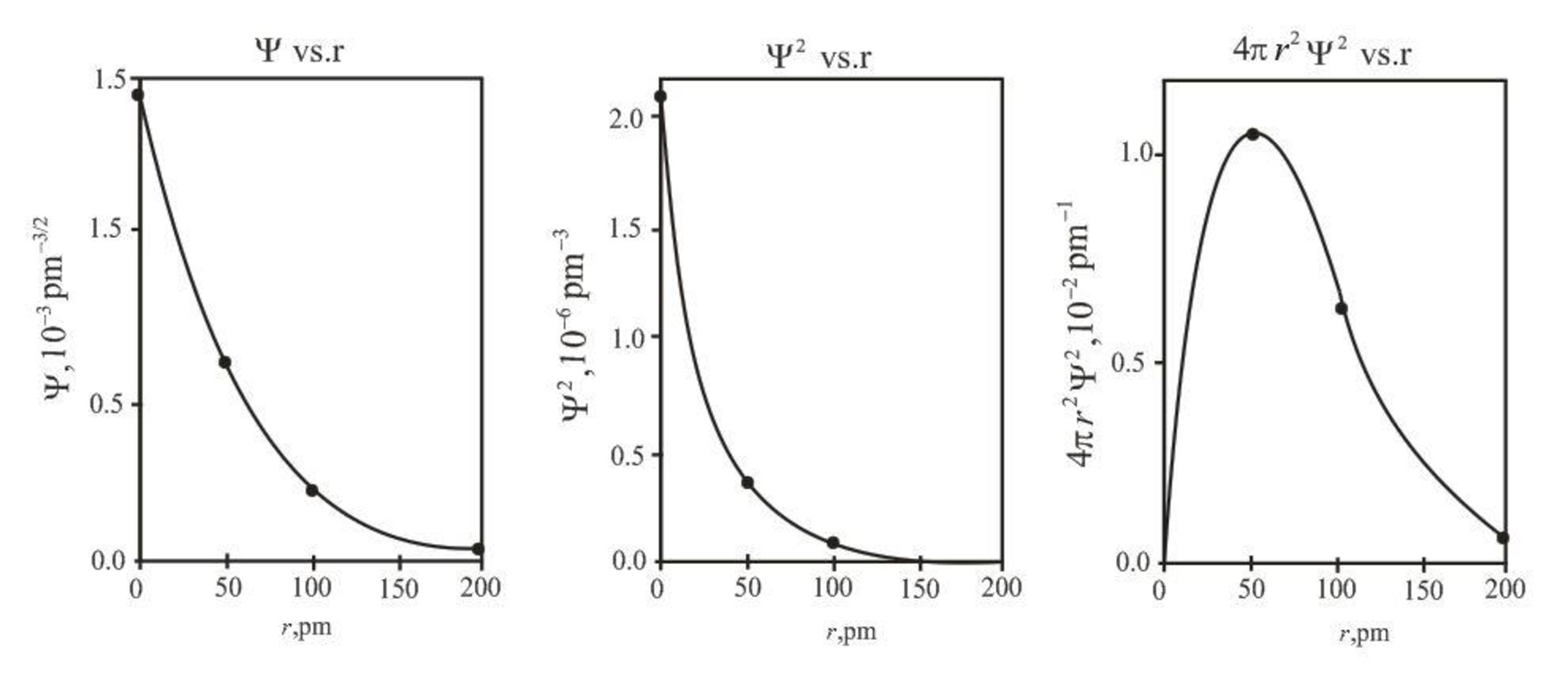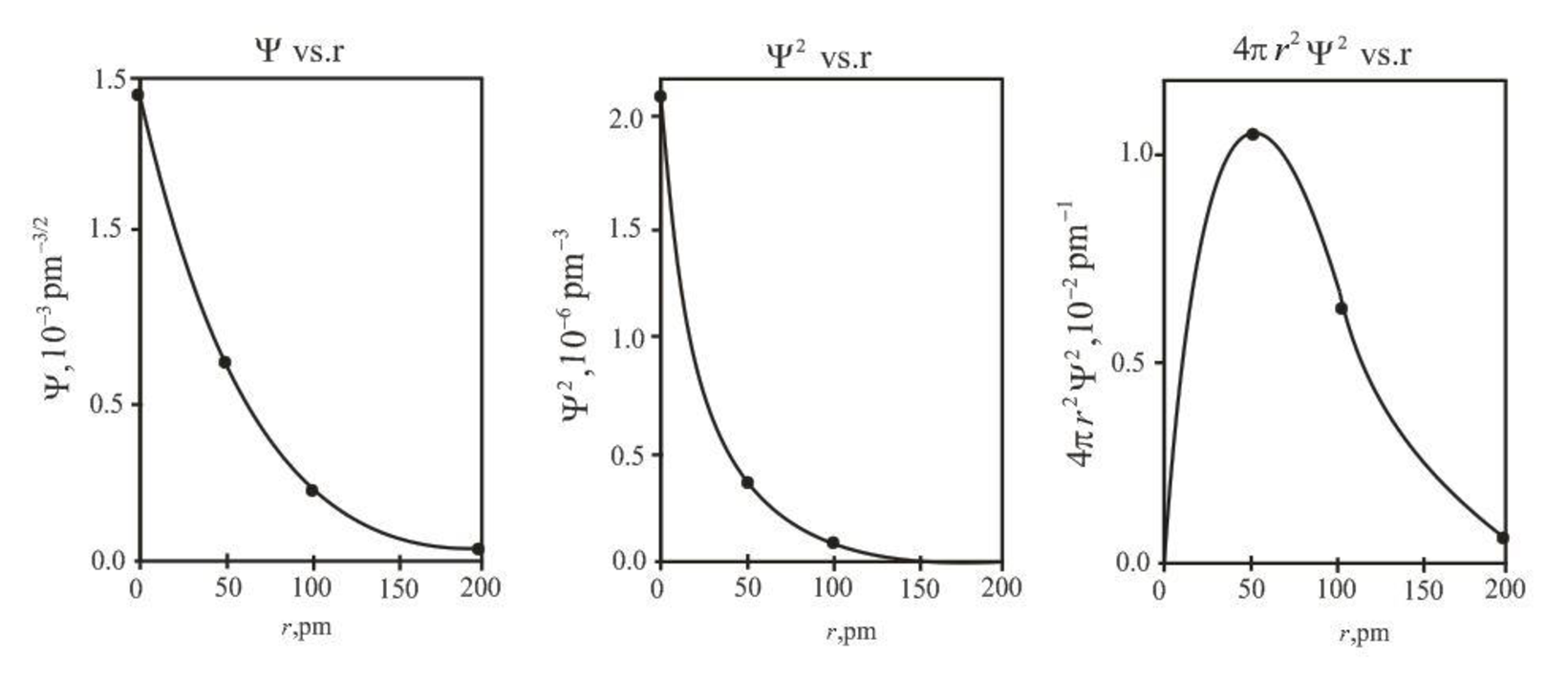
Concept explainers
Interpretation:
The value ψ2, ψ2 and 4πr2ψ2 for different value of r are to be calculated. Also, the graph between ψ versus radius, ψ2 versus radius and 4πr2ψ2 versus radius is to be drawn.
Concept introduction:
Quantum mechanics helps to understand the wave nature of particles. According to de Broglie, particles like electrons exhibit wave-like properties along with their particle properties.
The Schrodinger wave equation is represented as follows:
∧Hψ=Eψ
Here,
E is the energy of the atom.
∧H is the Hamiltonian operator.
ψ is the wave function.
In the Schrodinger wave equation, ψ represents the wave function. The wave function represents the wave associated with a particle. It has no physical significance.
However, the square of the wave function (ψ2) gives the probability of finding an electron at a particular point and time. Thus it becomes possible to determine the region in an atom around the nucleus where there is a high possibility of finding an electron with a certain amount of energy. This region is called an atomic orbital.
The symbol ψ2 denotes the probability density. It gives the probability of finding an electron in an extremely small region in the atom
The expression to calculate the wave number of 1s the orbital is as follows:
ψ=1√π(1ao)32e−rao (1)
Here,
ψ is the wave function.
r is the distance from the nucleus.
Answer to Problem 7.79P
The value of ψ2, ψ2 and 4πr2ψ2 for different value of r are as follows:
r(pm)ψψ24πr2ψ201.47×10−32.15×10−60500.570×10−30.325×10−61.02×10−21000.221×10−30.0491×10−60.0616×10−22000.0335×10−30.00112×10−60.0563×10−2
The graph between ψ versus radius, ψ2 versus radius and 4πr2ψ2 versus r is as follows:

Explanation of Solution
Substitute 52.92 pm for ao, 0 for r in the equation (1).
ψ=1√π(152.92 pm)32e−052.92 pm=1.465532×10−3=1.47×10−3
The expression to calculate the probability density of electrons is as follows:
Probability density of electron=ψ2 (2)
Substitute 1.465532×10−3 for ψ in the equation (2).
Probability density of electron=(1.465532×10−3)2=2.15×10−6 pm−3
The expression to calculate the mass of an electron is as follows:
Mass of electron=4πr2ψ2 (3)
Substitute 2.15×10−6 pm−3 for ψ2 and 0 for r in the equation (3).
Mass of electron=4π(0)2(2.15×10−6 pm−3)=0
Substitute 52.92 pm for ao, 50 pm for r in the equation (1).
ψ=1√π(152.92 pm)32e−50 pm52.92 pm=1.465532(e−50 pm52.92 pm)=5.69724×10−4
Substitute 5.69724×10−4 for ψ in the equation (2).
Probability density of electron=(5.69724×10−4)2=3.24585×10−7 pm−3
Substitute 3.24585×10−7 for ψ2 and 50 pm for r in the equation (3).
Mass of electron=4π(50 pm)2(3.24585×10−7)=1.0197×10−2 pm−1
Substitute 52.92 pm for ao, 100 pm for r in the equation (1).
ψ=1√π(152.92 pm)32e−100 pm52.92 pm=1.465532(e−50 pm52.92 pm)=0.221×10−3
Substitute 0.221×10−3 for ψ in the equation (2).
Probability density of electron=(0.221×10−3)2=0.0491×10−6 pm−3
Substitute 0.0491×10−6 pm−3 for ψ2 and 50 pm for r in the equation (3).
Mass of electron=4π(50 pm)2(0.0491×10−6 pm−3)=0.616×10−2 pm−1
Substitute 52.92 pm for ao, 200 pm for r in the equation (1).
ψ=1√π(152.92 pm)32e−200 pm52.92 pm=1.465532(e−50 pm52.92 pm)=0.0335×10−3
Substitute 0.0335×10−3 for ψ in the equation (2).
Probability density of electron=(0.0335×10−3)2=0.00112×10−6 pm−3
Substitute 0.00112×10−6 pm−3 for ψ2 and 200 pm for r in the equation (3).
Mass of electron=4π(50 pm)2(0.00112×10−6 pm−3)=0.0563×10−2 pm−1.
The graph between ψ versus radius, ψ2 versus radius and 4πr2ψ2 versus r is as follows:

The graph between ψ2 versus radius plot has zero nodes.
Want to see more full solutions like this?
Chapter 7 Solutions
Connect 2-Year Access Card for Chemistry: The Molecular Nature of Matter and Change
- Determine if the following salt is neutral, acidic or basic. If acidic or basic, write the appropriate equilibrium equation for the acid or base that exists when the salt is dissolved in aqueous solution. If neutral, simply write only NR. Be sure to include the proper phases for all species within the reaction LiNO3arrow_forwardAn unknown weak acid with a concentration of 0.410 M has a pH of 5.600. What is the Ka of the weak acid?arrow_forward(racemic) 19.84 Using your reaction roadmaps as a guide, show how to convert 2-oxepanone and ethanol into 1-cyclopentenecarbaldehyde. You must use 2-oxepanone as the source of all carbon atoms in the target molecule. Show all reagents and all molecules synthesized along the way. & + EtOH H 2-Oxepanone 1-Cyclopentenecarbaldehydearrow_forward
- R₂ R₁ R₁ a R Rg Nu R₂ Rg R₁ R R₁₂ R3 R R Nu enolate forming R₁ R B-Alkylated carbonyl species or amines Cyclic B-Ketoester R₁₁ HOB R R₁B R R₁₂ B-Hydroxy carbonyl R diester R2 R3 R₁ RB OR R₂ 0 aB-Unsaturated carbonyl NaOR Aldol HOR reaction 1) LDA 2) R-X 3) H₂O/H₂O ketone, aldehyde 1) 2°-amine 2) acid chloride 3) H₂O'/H₂O 0 O R₁ R₁ R R₁ R₁₂ Alkylated a-carbon R₁ H.C R₁ H.C Alkylated methyl ketone acetoacetic ester B-Ketoester ester R₁ HO R₂ R B-Dicarbonyl HO Alkylated carboxylic acid malonic ester Write the reagents required to bring about each reaction next to the arrows shown. Next, record any regiochemistry or stereochemistry considerations relevant to the reaction. You should also record any key aspects of the mechanism, such as forma- tion of an important intermediate, as a helpful reminder. You may want to keep track of all reactions that make carbon-carbon bonds, because these help you build large molecules from smaller fragments. This especially applies to the reactions in…arrow_forwardProvide the reasonable steps to achieve the following synthesis.arrow_forwardIdentify which compound is more acidic. Justify your choice.arrow_forward
- Provide the reasonable steps to achieve the following synthesis.arrow_forwardWhen anisole is treated with excess bromine, the reaction gives a product which shows two singlets in 1H NMR. Draw the product.arrow_forward(ii) Draw a reasonable mechanism for the following reaction: CI NaOH heat OH (hint: SNAr Reaction) :arrow_forward
 ChemistryChemistryISBN:9781305957404Author:Steven S. Zumdahl, Susan A. Zumdahl, Donald J. DeCostePublisher:Cengage Learning
ChemistryChemistryISBN:9781305957404Author:Steven S. Zumdahl, Susan A. Zumdahl, Donald J. DeCostePublisher:Cengage Learning ChemistryChemistryISBN:9781259911156Author:Raymond Chang Dr., Jason Overby ProfessorPublisher:McGraw-Hill Education
ChemistryChemistryISBN:9781259911156Author:Raymond Chang Dr., Jason Overby ProfessorPublisher:McGraw-Hill Education Principles of Instrumental AnalysisChemistryISBN:9781305577213Author:Douglas A. Skoog, F. James Holler, Stanley R. CrouchPublisher:Cengage Learning
Principles of Instrumental AnalysisChemistryISBN:9781305577213Author:Douglas A. Skoog, F. James Holler, Stanley R. CrouchPublisher:Cengage Learning Organic ChemistryChemistryISBN:9780078021558Author:Janice Gorzynski Smith Dr.Publisher:McGraw-Hill Education
Organic ChemistryChemistryISBN:9780078021558Author:Janice Gorzynski Smith Dr.Publisher:McGraw-Hill Education Chemistry: Principles and ReactionsChemistryISBN:9781305079373Author:William L. Masterton, Cecile N. HurleyPublisher:Cengage Learning
Chemistry: Principles and ReactionsChemistryISBN:9781305079373Author:William L. Masterton, Cecile N. HurleyPublisher:Cengage Learning Elementary Principles of Chemical Processes, Bind...ChemistryISBN:9781118431221Author:Richard M. Felder, Ronald W. Rousseau, Lisa G. BullardPublisher:WILEY
Elementary Principles of Chemical Processes, Bind...ChemistryISBN:9781118431221Author:Richard M. Felder, Ronald W. Rousseau, Lisa G. BullardPublisher:WILEY





